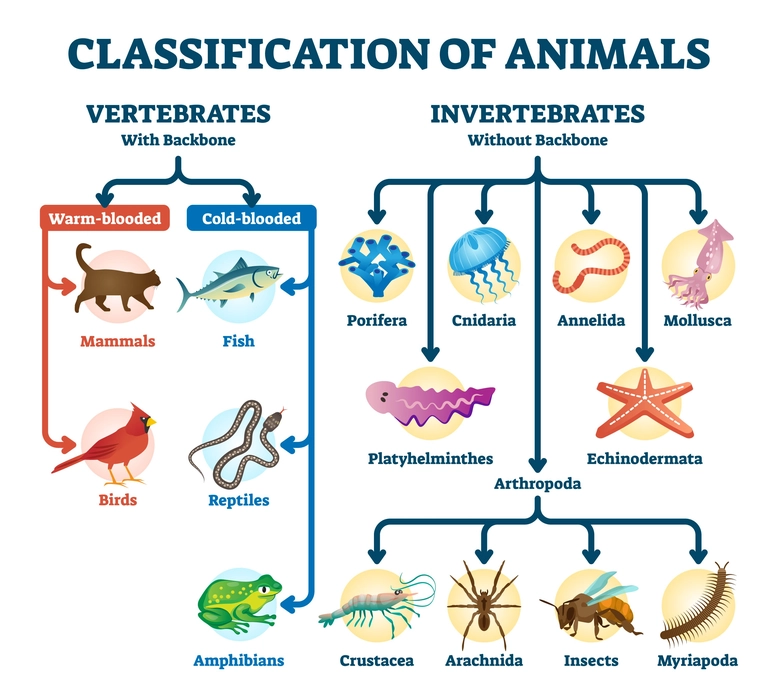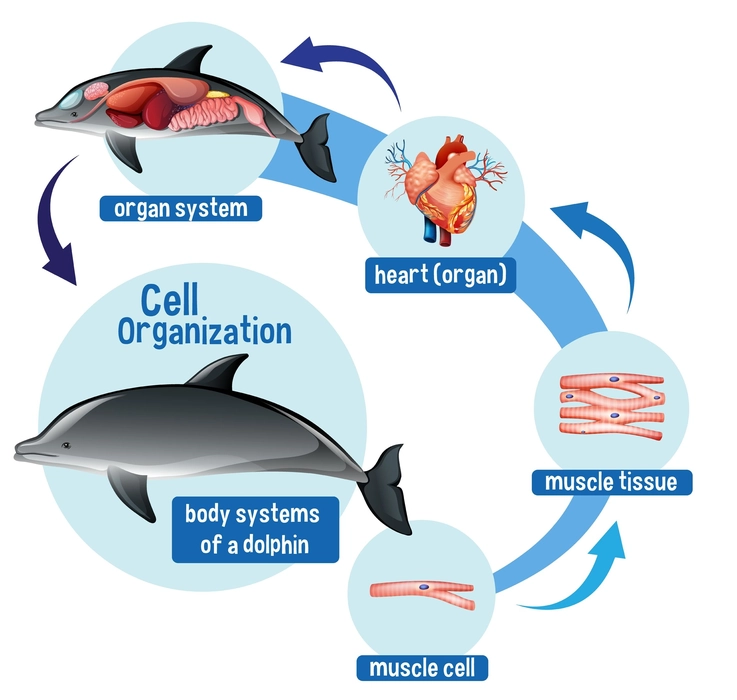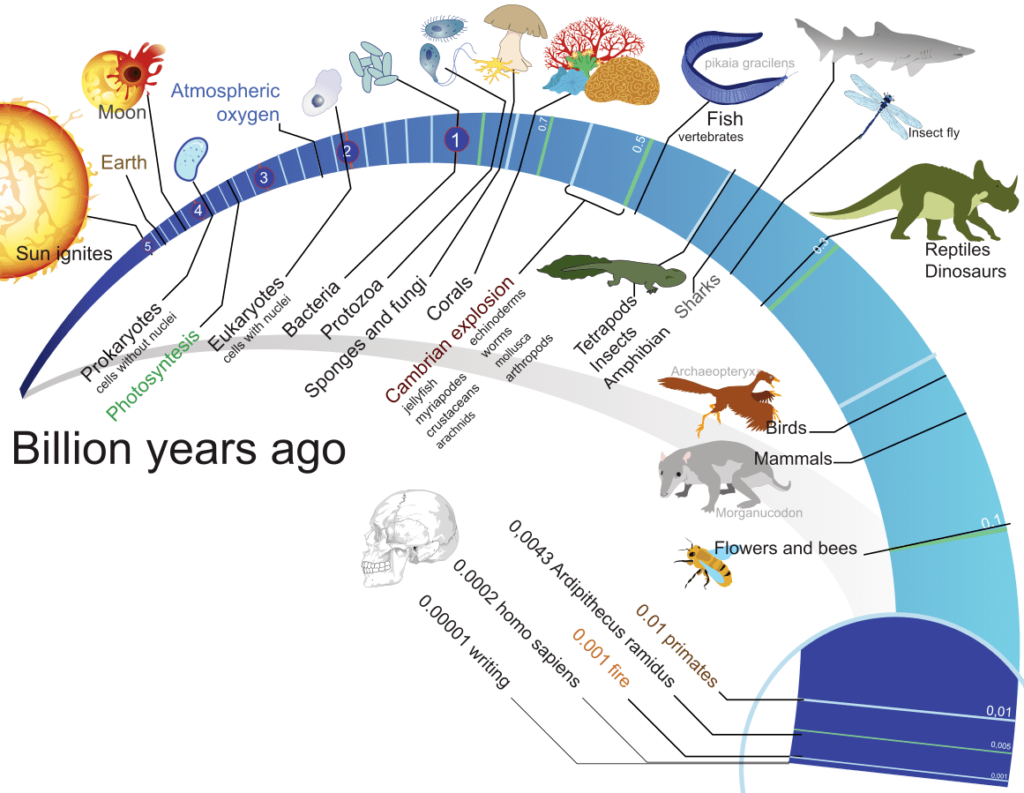Introduction
Animals come in a variety of shapes and sizes. Members of this kingdom are Multicellular, eukaryotic animals that have a heterotrophic mode of nutrition and their cells are devoid of cell walls. They are typically motile that move from one place to another. Animals come in a variety of shapes and sizes.
Classification of Animal kingdoms based on their characteristics
Animal classification is based on various characteristics such as
- Arrangement of cells
- Symmetry
- Coelom or body cavity
Arrangement of cells
All animals are multicellular but the arrangement of cells within them is different. This arrangement of cells is known as the levels of the organization. Based on this animals are classified under
- The cellular level of organization- Animals at this level of organization generate loose clusters of cells. Eg. Sponges.
- Tissue level of organization-Animals under this level has cells that combine to form tissues and all tissues perform various bodily activities.
- Organ level of organization- Animals with an organ-level organization are those in which tissues with the same functions group together to form an organ.
- Organ system level of organization-Organ system degree of organization is displayed when organs work together to produce an organ system that performs many physiological functions.
Symmetry
- The symmetry of an animal’s body can be used to classify it.
- The body exhibits three different types of symmetry.
- Asymmetry is symmetry where the plane is not divided into two equal halves. It was observed in the phylum Porifera (sponges).
- Radial symmetry is a symmetry that divides a plane passing through the central axis into two halves. This is seen in phylum Coelenterates, Ctenophores, and Echinoderms.
- When a plane separates the body into two identical left and right halves then such symmetry is known as bilateral symmetry.
- Arthropods and annelids are two examples of animals with bilateral symmetry.

Coelom or body cavity
- The coelom is the space that is found between the body wall and the alimentary canal. Based on body activity organisms are classified as-
- Acoelomates- They do not have a body cavity. Eg- members of Phylum Platyhelminthes.
- Pseudocoelomates–They have a false body cavity. Eg. members of Phylum Aschelminthes.
- Coelomate- They have a true body cavity that is filled with coelomic fluid. This is seen in members from Phylum Annelida to Phylum Chordata.
Phylum belonging to Kingdom Animalia
Phylum Porifera
- They are also known as sponges.
- They are multicellular organisms that are organized at the cellular level.
- They have asymmetrical body shapes and are typically found in marine environments.
- They have a water canal system. Water enters the body through the Ostia (pores) that are lined up on the surface of the body. From here it is conveyed into the spongocoel. Water exists in the body through the osculum.
- The movement of water facilitates gas exchange, food capture, and water excretion.
- Porifera members are Hermaphrodites.
- Common examples are Spongilla and Sycon.
Phylum Cnidaria
- They are aquatic, sessile, free-living, and radially symmetric creatures.
- On their body, tentacles, have stinging capsules called cnidoblast. These cnidoblasts
- are defense mechanisms of the organism and it also helps in anchorage.
- They display tissue-level organization and diploblastic structure.
- They have a single opening mouth on the hypostome and both internal and external digesting systems.
- The basic body forms that Cnidarians displays are the polyp and the Medusa.
- Physalia and Adamsia are two examples.
Phylum Platyhelminthes
- They are called flatworms because of their dorsally flattened bodies.
- They live inside animals, including humans, and are endoparasitic.
- Some of them take nourishment straight from their host.
- They are triploblastic, bilaterally symmetric animals that are organized at the organ level.
- They have no true internal body to accommodate well-developed organs for proper functioning.
- The development happens throughout several larval stages. Fertilization is internal.
- Taenia and Fasciola are two examples.
Phylum Annelida
- They can have a closed circulatory system and can either be terrestrial or aquatic, parasitic or free-living.
- They exhibit bilateral symmetry and organ-level organization.
- Segments and metameres are found on the body surfaces.
- Circular muscles in their bodies aid in mobility.
- The Annelida species perform sexual reproduction.
- Examples-Nereis and Hirudinaria.
Phylum Arthropoda
- In the Kingdom Animalia, it is the largest phylum that includes insects.
- They show bilateral symmetry and organ-level structure.
- They have joint legs and a tough exoskeleton
- Arthropods have a chitinous layer covering their belly, thorax, and other body parts.
- Through Malpighian tubules, they excrete.
- The development may be direct or indirect, and fertilization is typically internal.
- Eg- Cockroaches, Flies, Bees, etc.
Phylum Mollusca
- They are the second-largest phylum of the kingdom Animalia.
- They have an organ level of organization and may be terrestrial or aquatic.
- They have true bodies, triploblastic organization, and show bilateral symmetry.
- Most molluscs have calcareous shells covering their bodies.
- The head, visceral hump, and muscular foot make up the body.
- Internal fertilization occurs and they show indirect development.
- Examples include Pila and Chaetopleura.
Phylum Echinodermata
- Animals have calcareous skin coverings.
- They exist in aquatic settings that are organized at the organ level.
- While adults have radial symmetry, larval-stage animals have bilateral symmetry.
- They have a water vascular system that aids in breathing, locomotion, and food collection.
- There is no excretory system in them.
- Echinoderms show external fertilization and reproduce through sexual reproduction.
- Asteria and Echinus are examples.
Phylum Protochordata
- These creatures are triploblastic and bilaterally symmetric.
- They have a true body and, at some point in their life cycle, a notochord is present.
- They typically inhabit marine areas.
- Examples are Herdmania and Amphioxus.
Phylum Chordata
- This phylum includes creatures like birds and humans.
- The presence of a notochord is a trait shared by all species in this phylum.
- They have a single, hollow central nervous system that is located dorsally.
- A post-anal tail is present, which aids with movement.
- A pharynx is penetrated by gill slits.
- The phylum is further divided into subphyla Urochordata, Cephalaochordata, and Vertebrata.

Summary
The largest kingdom that includes all animals is called Kingdom Animalia. Several criteria, including the level of organization, symmetry, coelom, segmentation, and notochords, are used to classify these species. Various phyla such as Porifera, Cnidaria, Ctenophora, Platyhelminthes, Annelida, Arthropoda, Mollusca, Echinodermata, Protochordata, and Chordata make up this Kingdom.
Frequently asked question
1. Describe protozoans.
Ans: Protozoans are-
- Microscopic, unicellular, free-living protozoa are present in practically all ecosystems.
- They are typically parasitic and mobile.
- Digestion of food by these organisms takes place through the process of Osmotrophy, which is the engulfment of food through cell membranes.
2. How are animals classified based on the circulatory system?
Ans: A network of arteries, veins, capillaries, and the Heart together is known as the circulatory system. There are two types of circulatory systems: open and closed systems.
- In an open system, the blood is pumped into a chamber outside the heart known as the hemocoel rather than being constrained to the blood vessels.
- In a closed system, the blood circulates in one direction from the heart to the surrounding vessels and then returns to the heart. In this system, the blood is contained within the blood capillaries.
3. What do diploblastic organization and triploblastic organization mean?
Ans:
- Diploblastic organization – It is the arrangement of cells in two layers, i.e outer ectoderm and inner endoderm. It is seen in Coelenterates
- Triploblastic organization -It is a three-layered arrangement of cells, i.e ectoderm, mesoderm, and endoderm. Common examples are Platyhelminthes, chordates, etc.

